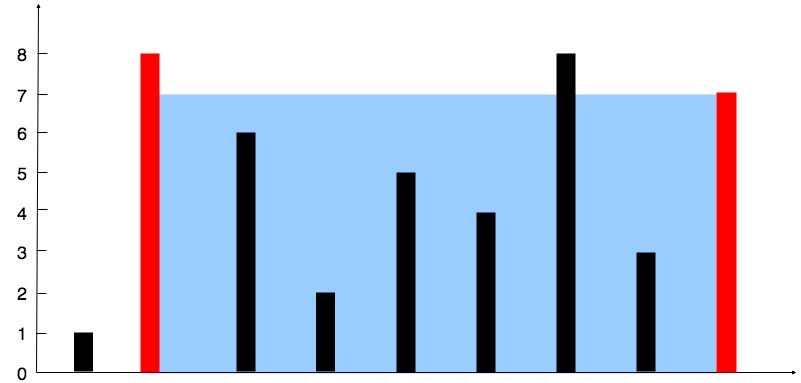0011. Container with Most Water¶
Given n non-negative integers a1, a2, ..., an , where each represents a point at coordinate (i, ai). n vertical lines are drawn such that the two endpoints of the line iis at (i, ai) and (i, 0). Find two lines, which, together with the x-axis forms a container, such that the container contains the most water.
Notice that you may not slant the container.

Input: height = [1,8,6,2,5,4,8,3,7]
Output: 49
Explanation: The above vertical lines are represented by array [1,8,6,2,5,4,8,3,7]. In this case, the max area of water (blue section) the container can contain is 49.
Example 2:
Input: height = [1,1]
Output: 1
Example 3:
Input: height = [4,3,2,1,4]
Output: 16
Example 4:
Input: height = [1,2,1]
Output: 2
Constraints:
n == height.length2 <= n <= 1050 <= height[i] <= 104
Using two pointers¶
if a_i > a_j:
then j --
else
then i ++
until two pointers have met
Proof: Assume the answer is i^{'} and j^{'} where (i^{'} < j^{'}), use S^{'} to represent the total water. Also assume a_i > a_j, so i to j - 1 should have the answer. We need to prove it is correct by showing optimal isn't in i + 1 to j Assume there is another S that is greater than S^{'}, then S = \min(a_i, a_j) \times (j - i) and j > j^{'} = a_i \times (j - i) > a_i \times (j^{'} - i) \geqslant \min(a_i, a_{j^{'}}) \times (j^{'} - i) = S^{'}
Code¶
class Solution {
public:
int maxArea(vector<int>& height) {
int res = 0;
for (int i = 0, j = height.size() - 1; i < j; )
{
res = max(res,
min(height[i], height[j]) * (j - i));
if (height[i] > height[j]) j -- ;
else i ++ ;
}
return res;
}
};